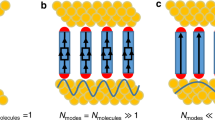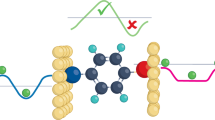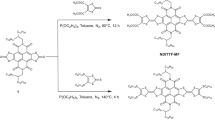Abstract
Electronic transport through single molecules has been studied extensively by academic1,2,3,4,5,6,7,8 and industrial9,10 research groups. Discrete tunnel junctions, or molecular diodes, have been reported using scanning probes11,12, break junctions13,14, metallic crossbars6 and nanopores8,15. For technological applications, molecular tunnel junctions must be reliable, stable and reproducible. The conductance per molecule, however, typically varies by many orders of magnitude5. Self-assembled monolayers (SAMs) may offer a promising route to the fabrication of reliable devices, and charge transport through SAMs of alkanethiols within nanopores is well understood, with non-resonant tunnelling dominating the transport mechanism8. Unfortunately, electrical shorts in SAMs are often formed upon vapour deposition of the top electrode16,17,18, which limits the diameter of the nanopore diodes to about 45 nm. Here we demonstrate a method to manufacture molecular junctions with diameters up to 100 µm with high yields (> 95 per cent). The junctions show excellent stability and reproducibility, and the conductance per unit area is similar to that obtained for benchmark nanopore diodes. Our technique involves processing the molecular junctions in the holes of a lithographically patterned photoresist, and then inserting a conducting polymer interlayer between the SAM and the metal top electrode. This simple approach is potentially low-cost and could pave the way for practical molecular electronics.
This is a preview of subscription content, access via your institution
Access options
Subscribe to this journal
Receive 51 print issues and online access
$199.00 per year
only $3.90 per issue
Buy this article
- Purchase on Springer Link
- Instant access to full article PDF
Prices may be subject to local taxes which are calculated during checkout





Similar content being viewed by others
References
Reed, M. A., Zhou, C., Muller, C. J., Burgin, T. P. & Tour, J. M. Conductance of a molecular junction. Science 278, 252–254 (1997)
Joachim, C., Gimzewski, J. K. & Aviram, A. Electronics using hybrid-molecular and mono-molecular devices. Nature 408, 541–548 (2000)
Nitzan, A. & Ratner, M. A. Electron transport in molecular wire junctions. Science 300, 1384–1389 (2003)
Aviram, A. & Ratner, M. A. Molecular rectifiers. Chem. Phys. Lett. 29, 277–283 (1974)
Salomon, A. et al. Comparison of electronic transport measurements on organic molecules. Adv. Mater. 15, 1881–1890 (2003)
Szuchmacher Blum, A. et al. Molecularly inherent voltage-controlled conductance switching. Nature Mater. 4, 167–172 (2005)
Collier, C. P. et al. Electronically configurable molecular-based logic gates. Science 285, 391–394 (1999)
Wang, W., Lee, T. & Reed, M. A. Mechanism of electron conduction in self-assembled alkanethiol monolayer devices. Phys. Rev. B 68, 035416 (2003)
Zhitenev, N. B., Meng, H. & Bao, Z. Conductance of small molecular junctions. Phys. Rev. Lett. 88, 226801 (2002)
Chen, Y. et al. Nanoscale molecular-switch crossbar circuits. Nanotechnology 14, 462–468 (2003)
Cui, X. D. et al. Reproducible measurements of single-molecule conductivity. Science 294, 571–574 (2001)
Engelkes, V. B. et al. Length-dependent transport in molecular junctions based on SAMs of alkanethiols and alkanedithiols: Effect of metal work function and applied bias on tunneling efficiency and contact resistance. J. Am. Chem. Soc. 126, 14287–14296 (2004)
Reichert, J. et al. Driving current through single organic molecules. Phys. Rev. Lett. 88, 176804 (2002)
Smit, R. H. M. et al. Measurement of the conductance of a hydrogen molecule. Nature 419, 906–909 (2002)
Zhou, C. et al. Nanoscale metal/self-assembled monolayer/metal heterostructures. Appl. Phys. Lett. 71, 611–613 (1997)
de Boer, B. et al. Metallic contact formation for molecular electronics: Interactions between vapor-deposited metals and self-assembled monolayers of conjugated mono- and dithiols. Langmuir 20, 1539–1542 (2004)
Haick, H., Ghabboun, J. & Cahen, D. Pd versus Au as evaporated metal contacts to molecules. Appl. Phys. Lett. 86, 042113 (2005)
Haynie, B. C. et al. Adventures in molecular electronics: how to attach wires to molecules. Appl. Surf. Sci. 203/204, 433–436 (2003)
de Boer, B. et al. Synthesis and characterization of conjugated mono- and dithiol oligomers and characterization of their self-assembled monolayers. Langmuir 19, 4272–4284 (2003)
Love, J. C. et al. Self-assembled monolayers of thiolates on metals as a form of nanotechnology. Chem. Rev. 105, 1103–1169 (2005)
Porter, M. D. et al. Spontaneously organized molecular assemblies. 4. Structural characterization of n-alkyl thiol monolayers on gold by optical ellipsometry, infrared spectroscopy, and electrochemistry. J. Am. Chem. Soc. 109, 3559–3568 (1987)
Chang, S.-C. et al. Investigation of a model molecular-electronic rectifier with an evaporated Ti-metal top contact. Appl. Phys. Lett. 83, 3198–3200 (2003)
Simmons, J. G. Generalized formula for the electric tunnel effect between similar electrodes separated by a thin insulating film. J. Appl. Phys. 34, 1793–1803 (1963)
Acknowledgements
We thank M. Mulder, T. C. T. Geuns, E. A. Meulenkamp, E. Cantatore and S. Bakker for their assistance, and the Materials Science CentrePlus for financial support.
Author information
Authors and Affiliations
Corresponding author
Ethics declarations
Competing interests
Reprints and permissions information is available at npg.nature.com/reprintsandpermissions. The authors declare no competing financial interests.
Supplementary information
Supplementary Notes
This file contains the Supplementary Methods and Supplementary Figures. (PDF 242 kb)
Rights and permissions
About this article
Cite this article
Akkerman, H., Blom, P., de Leeuw, D. et al. Towards molecular electronics with large-area molecular junctions. Nature 441, 69–72 (2006). https://doi.org/10.1038/nature04699
Received:
Accepted:
Issue Date:
DOI: https://doi.org/10.1038/nature04699
This article is cited by
-
Plasmonic phenomena in molecular junctions: principles and applications
Nature Reviews Chemistry (2022)
-
Large emergent optoelectronic enhancement in molecularly cross-linked gold nanoparticle nanosheets
Communications Chemistry (2022)
-
Printable logic circuits comprising self-assembled protein complexes
Nature Communications (2022)
-
CNT-molecule-CNT (1D-0D-1D) van der Waals integration ferroelectric memory with 1-nm2 junction area
Nature Communications (2022)
-
Nanoelectronic circuit elements based on nanoscale metal–molecular networks
Journal of Computational Electronics (2022)
Comments
By submitting a comment you agree to abide by our Terms and Community Guidelines. If you find something abusive or that does not comply with our terms or guidelines please flag it as inappropriate.



